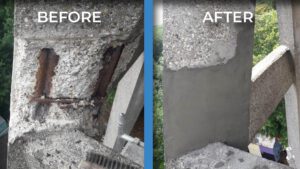Crack and Structural Concrete Repair
Concrete is one of mankind’s greatest inventions, but it can deteriorate over time due to harsh conditions or age. Often, Concrete Repair Colorado Springs are needed to prevent damage or keep structures functioning properly.
With the right products, these concrete repair projects can be easy and inexpensive. The most important step is evaluating the structure and determining what caused its deterioration.
Crack repair is a critical part of concrete restoration. A crack that is left untreated can reduce load-carrying capacity and speed up fatigue failure. This can be especially important for structures such as bridges, dams, tanks, and reservoirs.
The most effective method for repairing cracks in concrete depends on the type and cause of the cracking. To determine the cause of deterioration or distress, it is recommended to perform a condition evaluation, which may include a review of design and construction documents, a visual inspection of the structure in its current state, destructive and nondestructive testing, chemical analysis and petrographic analysis of concrete samples, and a structural analysis of the deteriorated structure.
Once the cause of the cracking is determined, it can be decided if the cracks are active or dormant. If the cracks are caused by intrinsic volume changes such as drying shrinkage or thermal contraction, then they will probably stabilize over time, and no further repair is required. However, cracks that indicate a design, detailing, or construction error are likely to affect the loading capacity of the structure and therefore need to be addressed.
To begin the crack repair process, all areas of the damaged concrete should be clean and dry. It is suggested that the cracks be cleaned out using a small hammer and chisel to chip away any loose or thin concrete up to a depth of about one inch below the surface. This should be followed by sweeping or vacuuming the area to remove any loose debris or dirt that has not been removed from the cracks by the cleaning tools. Finally, the area should be hosed down thoroughly to remove any remaining dust and dirt particles that could act as an insulator between the concrete and the new repair material.
The next step in the crack repair process is to prepare the damaged area for the application of the concrete crack repair product. If the cracks are leaking water, it is essential to dry the crack with a blow dryer or by allowing it to air dry for 15 minutes prior to beginning the repair. Once the crack is dry, it can be prepped for application by sanding or grinding to produce a smooth, flush surface that will accept coatings and paint.
Structural Repair
The structural repair of concrete is a crucial part of any building or structure and is often done during a rebuilding or renovation. This includes roofs, foundations, and floors, as well as glulam beams, purlins and sub-purlins, and trusses and columns made of either concrete, steel, or wood.
Structural repairs can be a complex project involving many different trades, but it is vital to get them right. The best way to ensure the job is done correctly is to engage a specialist who has experience in the design, construction, and repair of concrete structures. They can help you with early inspection and design to prevent problems in the future, as well as provide a comprehensive repair program with experienced staff to carry it out.
There are two major types of damage to concrete: physical and chemical. Physical deterioration causes surface damage such as cracking and spalling, and chemical deterioration causes corrosion of reinforcement steel within the concrete. Both cause distress to buildings or structures and must be addressed for long-term maintenance and durability.
When repairing concrete, it is important to use the proper materials to get the job done right. This can be determined by an initial condition evaluation of the concrete, which may include a visual inspection, destructive and nondestructive testing, and laboratory analysis. The resulting report will help determine the cause of the deterioration, and the appropriate repair methods and materials can be selected.
For example, if the problem is caused by the corrosion of reinforcement steel, cathodic protection may be an appropriate solution. This involves placing a small permanent current through the concrete to halt steel corrosion. This can greatly reduce the need to remove and replace damaged concrete.
For some projects, the type of repair materials will depend on the location as well as any environmental considerations. For instance, some locations are sensitive to odors, toxic chemicals, or combustible materials. In these cases, special epoxy repair products can be used. Similarly, if a repair is needed on equipment, it’s important to choose materials that will set up quickly and not interfere with ongoing operations.
Filling Cracks
Concrete is one of mankind’s greatest inventions, but like any material, it can become damaged. Whether the damage is structural, such as cracks, or non-structural, such as staining or erosion, the deterioration can lead to major problems. Luckily, patching and repairing concrete is relatively easy with the many specially formulated patch and repair products available these days.
Before starting any repair, it is important to determine the severity of the problem. Hairline cracks that are only visible from inside the home and on patios or sidewalks are usually not serious and can be filled without causing further damage. Larger cracks, however, should be inspected by a professional to make sure the cause is not a structural problem that requires more extensive repairs.
To repair concrete cracks 1/8 inch or narrower, apply an epoxy or latex patching product (view an example on Amazon), mixed according to the manufacturer’s directions. A mason’s trowel or putty knife should be used to force the product down into the crack and make it level with the surrounding concrete. Different mixes cure differently, so follow the directions on your chosen product carefully.
For larger cracks, a routing and sealing method may be appropriate. This involves widening the cracks, cleaning them, and then filling them with a sealant to prevent water from entering and causing further deterioration. Before using this method, it is recommended that you clean the cracked area thoroughly, scrub it with a wire brush or broom, and flush it with water to remove any loose debris. Then prepare the surface for the sealant by wetting it with a pressure washer. It is also important to note that this process is most effective on dormant cracks and should not be applied if the cracks are actively moving.
Another repair method that is sometimes employed in conjunction with routing and sealing is crack stitching. This entails drilling holes the length of the crack and then plugging them with grout or epoxy. This helps to “lock” the crack and reduce further movement of adjacent concrete sections. For this type of concrete repair, it is usually recommended that you use a polyurethane-based crack filler, such as Sakrete Non-Sag Crack Filler (view on Amazon). These products require acetone for cleaning and offer superior performance and durability over latex-based products.
Sealing
Concrete is a great building material that serves many purposes in and around our homes, but it can become damaged over time. Cracks, spalling, and erosion can reduce its usefulness and lead to other problems if not addressed. Luckily, many of today’s patch and repair products can help us restore concrete structures quickly and effectively.
Before beginning any concrete repair project, it is important to thoroughly clean the area and remove any dirt or debris. Doing so helps the repair materials adhere properly to the damaged surface and prevent future damage.
A band-aid fix for concrete cracks is simply mixing a polymer-modified cement product in water and wiping it over the cracked surface with a trowel. While this is neither a structurally sound solution nor a long-term cure, it may work if the cracks are symptomatic of the maturation process and not caused by pressure or torque.
When sealing cracks, it is important to choose a non-sag sealant or filler. There are a variety of such products available, including epoxies, silicones, and polyurethanes. The choice of which to use will depend on the type and severity of the crack, clean-up requirements, and desired durability.
It is recommended to apply a thin layer of bonding adhesive prior to applying the sealant or filler. This step is often overlooked, but it helps the repair material properly adhere to the damaged surface.
Once the bonding agent is dry, the cracks can be filled with a commercially available Portland cement-based concrete crack filler. Various grades are available, with the higher-strength, more durable options being more expensive. It is important to use a masonry crack filler that is suitable for the intended service load of the concrete structure.
For dormant, non-structural cracks, routing and sealing can be a quick and cost-effective repair method. There are a variety of products available, including epoxies, polyurethanes, and cement-based fillers and mortars. The most important consideration is choosing a product that is compatible with the damaged concrete and that can be easily applied.





